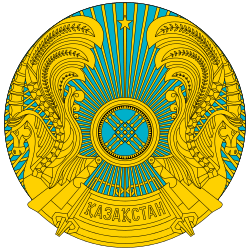Kazakh Steppe

The Kazakh Steppe, also called the Great Dala, ecoregion, of the Palearctic temperate grasslands, savannas, and shrublands biome, is a vast region of open grassland in northern Kazakhstan and adjacent portions of Russia, extending to the east of the Pontic steppe and to the west of the Emin Valley steppe, with which it forms part of the Eurasian steppe.
Setting
The steppe extends more than 2,200 km from the area east of the Caspian Depression and north of the Aral Sea, all the way to the Altai Mountains. It is the largest dry steppe region on earth, covering approximately 804,500 square kilometers. The Kazakh Steppe lies at the southern end of the Ural Mountains, the traditional dividing line between Europe and Asia. Much of the steppe is considered to be semi-desert, grading into desert as one goes further south. The Turan Lowland lies in the southwestern part of the steppe, but elevation increases as one travels east or to the northern parts of the steppe, with a few exceptions.
The Pontic Steppe lies to the west and northwest. To the north and northeast of the Kazakh Steppe lies the Kazakh forest steppe, an ecoregion of pine groves interspersed with grasslands that forms a transition between the Kazakh steppe and the forests of Siberia. To the south lies the Kazakh semi-desert and the Kazakh upland ecoregions. The Kokchetav Massif in north-central Kazakhstan harbors an enclave of the Kazakh upland, distinct from the Kazakh steppe which surrounds it at lower elevations.
Climate
The region has a semi-arid, continental climate, with most of the area falling under the "BSk" classification under the Köppen climate classification system. The steppe receives from 200mm to 400mm of precipitation in an average year, with more falling in the northern areas of the steppe. Average temperatures in July range from 20C to 26C, and -12C to -18C in January. Very high winds sweep across the plains at times.
| Climate data for Astana | |||||||||||||
|---|---|---|---|---|---|---|---|---|---|---|---|---|---|
| Month | Jan | Feb | Mar | Apr | May | Jun | Jul | Aug | Sep | Oct | Nov | Dec | Year |
| Record high °C (°F) | 4 (39) |
5 (41) |
22 (72) |
30 (86) |
36 (97) |
40 (104) |
42 (108) |
39 (102) |
36 (97) |
27 (81) |
19 (66) |
5 (41) |
42 (108) |
| Average high °C (°F) | −12 (10) |
−11 (12) |
−4 (25) |
9 (48) |
19 (66) |
25 (77) |
27 (81) |
24 (75) |
18 (64) |
8 (46) |
−2 (28) |
−9 (16) |
7 (45) |
| Daily mean °C (°F) | −15 (5) |
−15 (5) |
−9 (16) |
5 (41) |
13 (55) |
19 (66) |
21 (70) |
18 (64) |
12 (54) |
4 (39) |
−6 (21) |
−12 (10) |
3 (37) |
| Average low °C (°F) | −21 (−6) |
−21 (−6) |
−15 (5) |
−2 (28) |
5 (41) |
11 (52) |
13 (55) |
11 (52) |
5 (41) |
−1 (30) |
−11 (12) |
−18 (0) |
−3 (27) |
| Record low °C (°F) | −52 (−62) |
−49 (−56) |
−38 (−36) |
−28 (−18) |
−11 (12) |
−2 (28) |
2 (36) |
−2 (28) |
−8 (18) |
−26 (−15) |
−39 (−38) |
−44 (−47) |
−52 (−62) |
| Average precipitation mm (inches) | 22 (0.87) |
14 (0.55) |
19 (0.75) |
21 (0.83) |
31 (1.22) |
40 (1.57) |
50 (1.97) |
37 (1.46) |
26 (1.02) |
27 (1.06) |
20 (0.79) |
22 (0.87) |
327 (12.87) |
Flora
Because of low rainfall, the steppe has few trees, and consists of mostly grasslands and large, sandy areas.
Fauna
Animals that can be found in the steppes of Kazakhstan include the Saiga Antelope, Siberian Roe Deer, wolves, foxes, badgers, Mongolian gerbils and steppe tortoises.
People
The western part of the Kazakh Steppe is very sparsely populated, with between two and three people per square kilometer. As one heads east across the plains, the population density increases to between four and seven people per square kilometer. Kazakh people make up the majority of the people living in the area. Russia leases approximately 7,360 square kilometers in the southern region of the steppe for the world's oldest space launch facility, Baikonur Cosmodrome.
In popular culture
The movie Tulpan was shot and set in the Kazakh Steppe.
See also
- Saryarka — Steppe and Lakes of Northern Kazakhstan
- West Siberian Plain
- Category - Temperate grasslands, savannas, and shrublands
External links
- CIA, The World Factbook, 2004
- World Wildlife Fund (2001). "Kazakh steppe". WildWorld Ecoregion Profile. National Geographic Society. Archived from the original on 2010-03-08.
- "Kazakh steppe". Terrestrial Ecoregions. World Wildlife Fund.
- Saudi Aramco World,
- surfbirds.com,
- Map of the Kazakh Steppe,
| Alai-Western Tian Shan steppe | Kazakhstan, Tajikistan, Uzbekistan |
| Altai steppe and semi-desert | Kazakhstan |
| Central Anatolian steppe | Turkey |
| Daurian forest steppe | China, Mongolia, Russia |
| Eastern Anatolian montane steppe | Armenia, Iran, Turkey |
| Emin Valley steppe | China, Kazakhstan |
| Faroe Islands boreal grasslands | Faroe Islands, Denmark |
| Gissaro-Alai open woodlands | Kyrgyzstan, Tajikistan, Uzbekistan |
| Kazakh forest steppe | Kazakhstan, Russia |
| Kazakh steppe | Kazakhstan, Russia |
| Kazakh Uplands | Kazakhstan |
| Middle East steppe | Iraq, Syria |
| Mongolian-Manchurian grassland | China, Mongolia, Russia |
| Pontic steppe | Kazakhstan, Moldova, Romania, Russia, Ukraine, Bulgaria |
| Sayan Intermontane steppe | Russia |
| Selenge-Orkhon forest steppe | Mongolia, Russia |
| South Siberian forest steppe | Russia |
| Tian Shan foothill arid steppe | China, Kazakhstan, Kyrgyzstan |

